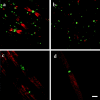Axo-glial interactions regulate the localization of axonal paranodal proteins
- PMID: 10601330
- PMCID: PMC2168103
- DOI: 10.1083/jcb.147.6.1145
Axo-glial interactions regulate the localization of axonal paranodal proteins
Abstract
Mice incapable of synthesizing the abundant galactolipids of myelin exhibit disrupted paranodal axo-glial interactions in the central and peripheral nervous systems. Using these mutants, we have analyzed the role that axo-glial interactions play in the establishment of axonal protein distribution in the region of the node of Ranvier. Whereas the clustering of the nodal proteins, sodium channels, ankyrin(G), and neurofascin was only slightly affected, the distribution of potassium channels and paranodin, proteins that are normally concentrated in the regions juxtaposed to the node, was dramatically altered. The potassium channels, which are normally concentrated in the paranode/juxtaparanode, were not restricted to this region but were detected throughout the internode in the galactolipid-defi- cient mice. Paranodin/contactin-associated protein (Caspr), a paranodal protein that is a potential neuronal mediator of axon-myelin binding, was not concentrated in the paranodal regions but was diffusely distributed along the internodal regions. Collectively, these findings suggest that the myelin galactolipids are essential for the proper formation of axo-glial interactions and demonstrate that a disruption in these interactions results in profound abnormalities in the molecular organization of the paranodal axolemma.
Figures




References
-
- Black J.A., Kocsis J.D., Waxman S.G. Ion channel organization of the myelinated fiber. Trends Neurosci. 1990;13:48–54. - PubMed
-
- Bosio A., Bussow H., Adam J., Stoffel W. Galactosphingolipids and axono-glial interaction in myelin of the central nervous system. Cell Tissue Res. 1998;292:199–210. - PubMed
-
- Coetzee T., Fujita N., Dupree J., Shi R., Blight A., Suzuki K., Suzuki K., Popko B. Myelination in the absence of galactocerbroside and sulfatidenormal structure with abnormal function and regional instability. Cell. 1996;86:209–219. - PubMed
Publication types
MeSH terms
Substances
Grants and funding
LinkOut - more resources
Full Text Sources
Molecular Biology Databases

